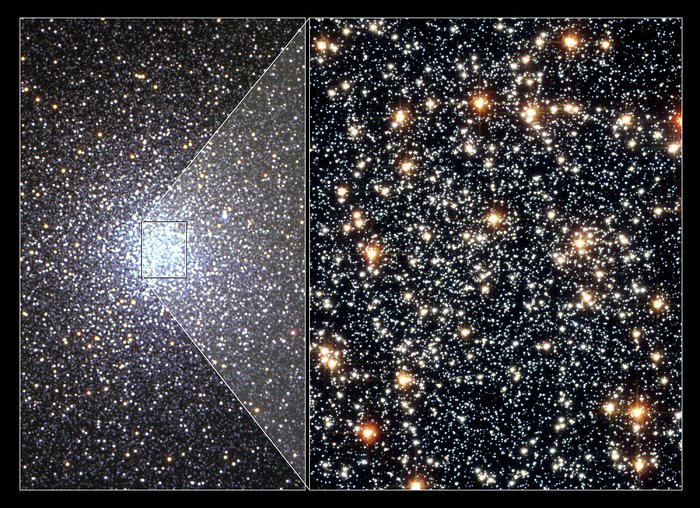Stellar sorting in globular cluster 47 Tucanae
A seven year study with the NASA/ESA Hubble Space Telescope has provided astronomers with the best observational evidence yet that globular clusters sort out stars according to their mass, governed by a gravitational billiard ball game between stars. Heavier stars slow down and sink to the cluster's core, while lighter stars pick up speed and move across the cluster to its periphery. This process, called "mass segregation", has long been suspected for globular star clusters, but has never before been directly seen in action.
[Left] - A photo of the globular star cluster 47 Tucanae taken with the Very Large Telescope, in Chile. It is one of the densest globular clusters in the Southern hemisphere. The cluster contains one million stars.
[Right] - An NASA/ESA Hubble Space Telescope colour photo of the core of 47 Tucanae. Multiple photos of this region allowed astronomers to track the "beehive swarm" motion of stars. Precise velocities were obtained for nearly 15,000 stars in this cluster. This image was taken with Hubble's Advanced Camera for Surveys.
The international team was made of the following scientists: D.E. McLaughlin (University of Leicester, UK), J. Anderson (Rice University, USA), G. Meylan (?cole Polytechnique Federale de Lausanne, Switzerland), K. Gebhardt (University of Texas at Austin, USA), C. Pryor (Rutgers University, USA), D. Minniti (Pontifica Universidad Catolica, Chile), and S. Phinney (Caltech, USA).
Credit:About the Image
| Id: | heic0616a |
| Type: | Collage |
| Release date: | 24 October 2006, 16:00 |
| Related releases: | heic0616 |
| Size: | 3000 x 2175 px |
About the Object
| Name: | 47 Tucanae |
| Type: | Milky Way : Star : Grouping : Cluster : Globular |
| Distance: | 15000 light years |
| Category: | Star Clusters |
Colours & filters
| Band | Wavelength | Telescope |
|---|---|---|
| Optical B | 475 nm |
Hubble Space Telescope
ACS |
| Ultraviolet |
Very Large Telescope (VLT)
FORS1 | |
| Optical V | 555 nm |
Hubble Space Telescope
ACS |
| Optical V |
Very Large Telescope (VLT)
FORS1 | |
| Infrared I | 814 nm |
Hubble Space Telescope
ACS |
| Optical R |
Very Large Telescope (VLT)
FORS1 |
Notes: The left image was captured by the ESO ground-based Very Large Telescope, and the right by the Hubble Space Telescope.

